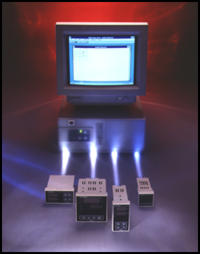With Multi-Comm, you can control up to 100 Athena C Series Temperature or Process Controllers connected via an RS-485 network using an IBM-compatible computer.* Up to sixteen controllers may be viewed on screen at one time with a color emulation of each instrument's front panel display showing process value and setpoint in real time.

 Pull-down menus
and pop-up windows make controller configuration and data analysis easy.
Pull-down menus
and pop-up windows make controller configuration and data analysis easy. Multiple operator security levels
and password protection prevent unauthorized access or accidental changes
to process parameters.
Multiple operator security levels
and password protection prevent unauthorized access or accidental changes
to process parameters. Automatic controller detection
locates and identifies each controller on the network.
Automatic controller detection
locates and identifies each controller on the network. User-defined 10-character controller
labels allow custom identification of any controller.
User-defined 10-character controller
labels allow custom identification of any controller. Provides each controller with two
additional local alarms (process hi/lo) without affecting other alarms.
Provides each controller with two
additional local alarms (process hi/lo) without affecting other alarms. Captures and time-stamps process
value and setpoint data to log file for subsequent storage and analysis.
Captures and time-stamps process
value and setpoint data to log file for subsequent storage and analysis. Displays graph window showing real-time
plot of process value vs. setpoint for any controller on network.
Displays graph window showing real-time
plot of process value vs. setpoint for any controller on network.*Min. requirements: 386SX, 1 Mb of free hard-disk space, Windows 3.1 or later.
Security Features
To prevent unauthorized changes to either controller or Multi-Comm parameters, operators must follow specific login and logout procedures. Each operator may have an individual user ID and password, which must be entered exactly the same each time access is requested. Operators may be assigned different security levels, depending on their specific access requirements. You may specify any or all of the following access privileges per operator:
 Change setpoint (access to change
controllers' setpoints)
Change setpoint (access to change
controllers' setpoints) View/change parameters (access
to controllers' parameters)
View/change parameters (access
to controllers' parameters) Controller configuration (access
to Multi-Comm configuration options)
Controller configuration (access
to Multi-Comm configuration options) Super user (access to add or change
operator passwords and privileges)
Super user (access to add or change
operator passwords and privileges)Communications Setup
Multi-Comm is designed for bidirectional communications to Athena Series XT or nXT controllers connected via an RS-485 hookup using an available RS-232 serial port on your computer. It allows you to easily set up your communications port, polling frequency and timeout frequency.
Controller Setup
Multi-Comm uses the network ID numbers you've assigned to your controllers in order to communicate to them. Using its Automatic Controller Detection (ACD) feature, Multi-Comm can find and identify each controller on the network automatically and label each controller with the network ID you've assigned it. You may also change its name to any 10-character designation.
Adding And Deleting Controllers
Multi-Comm allows you to remove individual controllers from software control and add them back at any time.
Local Alarms
Multi-Comm provides two additional ``local'' alarms for each controller on the network: one high process alarm and one low process alarm. They do not affect the operation of the controller's regular alarms.
Data Logging
Multi-Comm will capture the process and setpoint values of each controller on the network and save it to an ASCII file that can be read by any text editor or word processor. It will also give you the option of appending or overwriting data to an existing log file, when you specify the same log file name at a later date. The log data, which is time-stamped and identified with each controller's name, may also be imported directly into a Microsoft Excel spreadsheet for further analysis and graphing. Log time can be varied by the operator.
Graph Window
Multi-Comm allows an operator to visually track a selected controller's instantaneous setpoint and process values over a period of several minutes with an on-line graphing feature.
Specifications and features subject to change without notice.
IBM is a registered trademark of International Business Machines Corporation.
Microsoft, MS-DOS and Excel are registered trademarks of Microsoft Corporation.
Windows is a trademark of Microsoft Corporation.